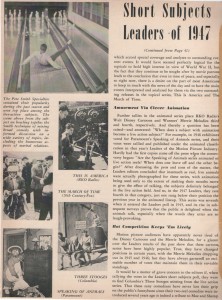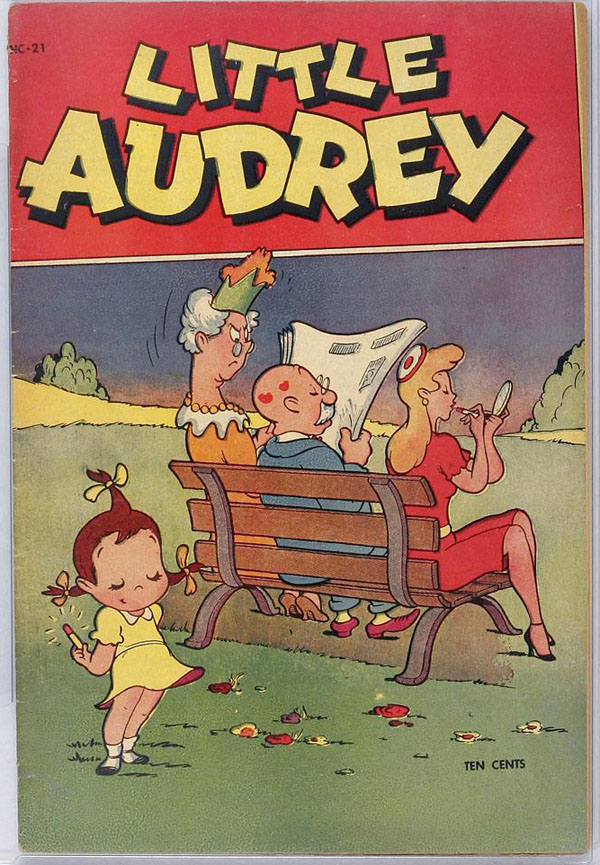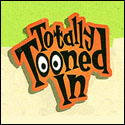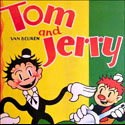The 1947-48 season was one of transition. The contractual arrangement with Marge, and the license for Little Lulu, had come to an end. The cartoons had not caught on with the public and by mutual agreement, the parties were willing to move on.
Popeye was still the star amongst the Famous Studio players – though new “stars” were being developed in the Noveltoon series. Herman the Mouse continued on (sans Henry), Buzzy the Crow and Little Audrey made their debuts; The Bored Cuckoo (by arrangement with “Funny Book Magazine”), Flip Flap (a Myron Waldman update of themes explored in Fleischer’s Playful Polar Bears), and We’re In The Honey (a mash-up of ideas already explored in Mr. Bug and Ants In The Plants) filled up the release schedule.
The Fall saw Paramount burning off the rest of their Little Lulu releases and to take her place, the studio readied its next shot at success – a full-fledged revival of the Screen Songs. Audience reception to the bouncing ball sing-alongs, which had been occasionally included in the previous seasons Noveltoons, was good enough to now warrant a larger platform.
As noted in the 1947 contract below – the new order for the season consisted of 24 cartoons, evenly divided (eight each) between Popeye, Noveltoons and Screen Songs. The new Screen Songs series began appearing in December 1947 with The Circus Comes To Clown. At the start of 1948, Paramount gave the series a boost with a fresh stock one-sheet (pictured, click to enlarge) and trade ads to theatre exhibitors (this one for the second entry, Base Brawl, embed below):





Sales Dept.
There’s no doubt that Paramount was thriving in the short subjects market – but not solely on Famous Studios product. The George Pal Puppetoons were their champs – and Speaking Of Animals had not worn out their welcome. Popeye is still an important factor in the mix (see the third page of the 3-page Showmen’s Trade Reviews annual piece below).



Little Audrey Department.
The Screen Songs replaced Little Lulu on the release charts, but another character replaced Lulu in the cartoons themselves. It was during the 1947-48 season that Little Audrey emerged publicly. Her debut was during the Christmas season, as a supporting player in the Noveltoon, Santa’s Surprise (12/5/47).
The studio was so high on Audrey, Paramount jumped right in to the lucrative licensing business; her theme song as sheet music and a series of comic books were the first out of the gate. Crafting a new deal with Archer St. John (his company was already thriving with Terrytoon comics acquired the year before), the first issue of Little Audrey hit the stands in the Spring of 1948, before the public really knew who she was. The cover of the first issue (pictured below) was an adaptation of this Bill Tytla gag drawing:


Little Audrey began making semi-annual Noveltoon appearances in mid-1948. Below is her first “starring role” as the new-Lulu: Butterscotch And Soda (7/6/48) – and dig that swing arrangement of her theme song.
For more on Little Audrey, please check this post from last December.
(Thanks to Don Yowp for assistance)


 Jerry Beck is a writer, animation producer, college professor and author of more than 15 books on animation history. He is a former studio exec with Nickelodeon Movies and Disney, and has written for The Hollywood Reporter and Variety. He has curated cartoons for DVD and Blu-ray compilations and has lent his expertise to dozens of bonus documentaries and audio commentaries on such. Beck is currently on the faculty of CalArts in Valencia, UCLA in Westwood and Woodbury University in Burbank – teaching animation history. More about Jerry Beck [
Jerry Beck is a writer, animation producer, college professor and author of more than 15 books on animation history. He is a former studio exec with Nickelodeon Movies and Disney, and has written for The Hollywood Reporter and Variety. He has curated cartoons for DVD and Blu-ray compilations and has lent his expertise to dozens of bonus documentaries and audio commentaries on such. Beck is currently on the faculty of CalArts in Valencia, UCLA in Westwood and Woodbury University in Burbank – teaching animation history. More about Jerry Beck [








That swing arrangement for the embedded Little Audrey cartoon is very reminiscent of the arrangement of the Donald Duck cartoons around this time. Did they use the same singers?
Reminds me of the popular “Boy/Girl” quartets they had in the 1940’s with the Big Bands like The Modernaires Mel-Tones and The Pied Pipers. A perfect example was the nightclub scene from Mr Bug Goes to Town (later Hoppity Goes to Town) where a boy/girl quartet was preforming the song “Katy Did, Katy Didn’t” (a play on the word Katydid a type of insect related to the Grasshopper).
Replying to Mr. Bigg here, you’re right. There were lots of those groups in the 40’s and pre-rock 50’s, it was a very popular sound. A number of Terrytoons from that time used it too, including Mighty Mouse in “Krakatoa,” “Love Is Blind,” and “Sparky the Firefly.” The woman’s voice who sings “oh, lovely island, island of Krakatoa” in the Mighty Mouse cartoon sounds A LOT like Jo Stafford. I don’t think it was actually her, but someone was doing a dead-on imitation!
Also, is that the first reference to “The Lost Weekend” in a cartoon, in “Butterscotch and Soda”?
Though The Lost Weekend was a Paramount “Best Picture” Oscar winner for 1945, Tex Avery had a Lost Weekend reference in KING SIZE CANARY (12/6/47) and Friz Freleng has one even earlier in SLICK HARE (11/1/47).
Oh yeah, didn’t “Slick Hare” have the gag where Ray Milland paid for his drink with his typewriter, and got three or four tiny typewriters in change (accompanied with theremin music)?
The elephant pitcher in “Base Brawl” is strikingly good. Moves like a real-life pitcher but one that weighs a ton or two. Too bad about the corny gags.
Having spent much of my childhood watching Screen Songs on TV, I always wondered if people in movie audiences ever actually sang along with them. Personally I would be mortified, but grant that people in the 40s may have been less inhibited, being closer to an era when canned entertainment didn’t exist and community sing-alongs were one thing you did for entertainment. Even so, they must have been a fading memory by then, and I can imagine a few older folks belting out “Take Me Out To the Ball Game” while the younger ones sat in uncomfortable silence, damned if they were going to let a cartoon turtle pressure them into being uncool.
Well, I don’t know about 1940’s-50’s houses, but we did sneak a print of CANDY CABARET (1954) into the middle of a Sons of Desert program last year. Even by the none too lofty Paramount Famous standards, this one is a particular groaner in the gag department, but surrounded by really great Laurel and Hardy and Our Gang comedies it played alarmingly well and the audience of about 90 chirped in right on cue to “Ain’t She Sweet.”
Yeah, the gags were consistently corny. Might be one or two worth a smile, but the vast majority of it clearly had little effort put into it in the gag department. Kinda supports the notion that these were real quickies to keep the studio kicking.
Granted I haven’t watched many, but were there any good Famous Screen Songs?
The mainline Noveltoon comedies tended to have better gag writing.
Well, ‘good’ is a strong word for the Screen Songs. But in my humble assessment, there are several that so limp, so awesomely lazy in the gag writing department that the actual entertainment quotient soars. The ‘Davenport Iowa’ joke in DRIPPY MISSISSIPPI is so, so… simple. Didn’t even need an animator! Over at MGM, Avery might have tossed this off as a throwaway, with a follow-up topper apologizing for being so corny. But here, it’s front and center like some sort of brilliant bon mot, eating up as much footage as they can possibly get away with. I mean, somebody WROTE this. Cracks me up every time! I love it! If I had to pick a favorite, it certainly would be VEGETABLE VAUDEVILLE.
Just a quick thank you for this series of posts, Jerry. You’re not alone in having a soft spot (probably in our heads) for Famous Studios. Love seeing the extra material (pencil drawings, publicity material, etc.).
Yeah, I love that version of Little Audrey’s theme!
So, technically, Audrey’s cartoons all fell under the Noveltoons banner, even though she had her own theme song and a “head shot” at the beginning of her films?
I’ll confess to being an adult to before I ever figured out all the words to Audrey’s theme song. The line “She knows her proverbs, a to z” had me stymied when I was a kid. Couldn’t make out exactly what the chorus was singing.
On the embedded print of “Base Brawl,” that NTA logo was one I’ve never seen before.
@Peter Mork: I can tell you that, when we were kids, that “Start your day with a song . . .” theme music meant that my brother was going to start yelling to change the channel. He’d watch just about any old cartoon if the chase-and-violence quotient was high enough, but he just HATED Screen Songs. He preferred changing the channel and watching ten minutes of THE MUNSTERS or I DREAM OF JEANNIE to sitting through one. He’d do that if a HAPPY HARMONIES came on, too. Or one of those early MERRIE MELODIES where everybody sings for five minutes then bands together to rescue whoever just got kidnapped by the bad guy.
I also recall several of the Mighty Mouse of the 1940’s and 1950’s where many of the characters including Pearl Pureheart and Oil Can Harry break out singing in either a opera or operetta style which makes wonder if Paul Terry was a aficionado of opera.
On the embedded print of “Base Brawl,” that NTA logo was one I’ve never seen before.
Those tend to come from prints produced during the 1970’s, it also shows up on the Betty Boop cartoons that were redrawn in color.
I wonder if the same group who sung the themes for Little Audrey and Screen Songs also sung the themes from Casper the Friendly Ghost and Herman and Katnip?
Thanx, Jerry!
I’d never seen Butterscotch before.
Wotta Krazy Kartoon Krossover – somehow Mammy Two Shoes is Little Audrey’s mother?
And a quick cameo by Herman… or a reasonable facsimile thereof?
Good stuff.
More likely it’s Mandy from the Little Lulu shorts, and notice that Lulu’s dog is there too. Makes one wonder if maybe this was originally developed as a Lulu and they simply replaced her with Audrey somewhere down the production line.
It does feel like it. Audrey doesn’t even talk much besides the opening section, and even her ‘trademark laugh’ hasn’t happened yet.
There was a Lulu gag pose a couple of weeks ago that was the exact same as the Audrey gag on the animation credit page, with thew cut-out hole in the baseball stadium fence. It doesn’t have anything to do with the actual story, but it does show at least some part of the cartoon was originally conceived before Audrey was formally put into production
I like The Harveytoons Show is my favorite cartoon anthology series mostly of animated theatrical shorts created by Famous Studios aired from 1950-62 TV series on ABC Network & reruns thru Retro TV YouTube & Netflix worldwide. Thanks for the information. From:Wayne. waynemoises@gmail.com
I luvvvvs me some Little Audrey!!!
I love hearing “You’ve got the Tummyache Blues” in the Butterscotch and Soda cartoon.
I have to admit to liking the LITTLE AUDREY series, especially the early entries as they tried to resemble the surrealism of the early LITTLE LULU shorts. It is the animation that saved the SCREEN SONGS for me, but I’m not really a big fan of these, and I guess that the loss of the MGM classic cartoons in my area at the time made it hard for me to accept these as replacement; the MGM toons were far more visually interesting. But now, their scarcety makes them more interesting to me. Like all other studios, the one shots were the most amazing.
I see that Base Brawl is one of the Paramount cartoons released in Polacolor. Polacolor was a 3-color dye process devised by W. H. Ryan and V. K. Walworth of the Polaroid Company to create color release prints using b&w stock. The process required three b&w color-separation negatives (negatives containing, respectively, the red-, green- and blue-filtered image – as was required for the Technicolor process) but used an ordinary b&w stock (such as Eastman 5302) which was prgressively exposed to the negative image, dyed the inverse color for that image, then resensitised (the remaining silver being rehalogenated) ready for exposure to the next negative.
Introduced in 1947, it was used on a selection of Famous Studio films, but Paramount never took the further step of using it for a feature release. This may have been due to the small scale and relative inaccessibility of the processing laboratory – Polaroid was based in Cambridge, Massachusetts whereas Technicolor had a lab in the heart of Hollywood geared up to large scale print production. In 1949, unwilling to fund a full scale laboratory in LA, Polaroid abandoned the process.
The Polacolor shorts are:
CAMPTOWN RACES
GOLDEN STATE
LONE STAR STATE
SING OR SWIM
WINTER DRAWS ON
THE CIRCUS COMES TO CLOWN
BASE BRAWL
POPEYE MEETS HERCULES
PRE-HYSTERICAL MAN
SNOW PLACE LIKE HOME
WIGWAM WHOOPEE
WOLF IN SHIEK’S CLOTHING
FLIP FLOP
Thank you, I’ve always been intesested in Polacolor, could never find much information on it. Figured it might be from poloroid. Now I know. Can you tell me anything about Vitacolor? Used in Last of the Redmen, Return of Rin Tin Tin.
There is a Wikipedia page on the various forms of ‘Technicolor’ and it’s history. There is a ‘Polacolor’ page as well, but nothing on ‘Vitacolor’.
P.S. There is also a page on Cinecolor.
The Popeye cartoons “Robin Hoodwinked”, “Symphony in Spinach”, “Lumberjack and Jill” and “Hot Air Aces” were in Polacolor as well.
It appears from your list that Polacolor was used only for cartoons (I stand to be corrected.) It could have been that Polaroid was able to develop their process only as far as a successive-exposure version for animation photography (the same system as Technicolor) but may have been unable to devise a simultaneous-exposure camera for live action. (3-color Technicolor was only for cartoons in the beginning as well, until they built that monster-sized live action camera Alfred Hitchcock called “the enchanted cottage.”)
Had they succeeded in doing so, they might then have faced the same kind of patent lawsuits Technicolor brought against Cinecolor when they introduced their 3-strip “Super-Cinecolor.” As it was, perhaps they felt a color process for cartoons only would not be lucrative enough, and let it drop.
In the end, all bets were off anyway once both Eastman Kodak and Ansco introduced all-in-one direct negative/positive color film stocks that could be used in any camera. (Cinecolor changed their name to Color Corporation of America and switched over completely to Ansco Color, but folded a couple years later. Ansco Color was really a fairly lousy-looking process in the first place.)
Paramount’s live action short subjects that were filmed in color (Popular Science, Unusual Occupations) used Cinecolor or “the new Magnacolor”.
Great Stuff! I always loved the Famous Studios Title art from this time period!
So, looking at the contracts, while Paramount retained all rights and trademarks, Buchwald, Kneitel and Sparber owned the company (or partnership rather) known as Famous Studios?
Oh and by the way, what building were they in? We learned a while back that the Miami studio is used for a police station. Any idea about the New York studio?
In New York, Famous Studios occupied spaces in two building off Times Square – in 25 West 45th Street and next door at 35 West 45th Street. More about their offices in future installments of this column.
Thank you for the reply! I’m looking forward to your next posts. There are some periods from Famous’ history I would definitely like to learn more about.
Just reminded myself, the second Casper cartoon, “THERE’S GOOD BOOS TO-NIGHT” came out during this season. While nothing to write home about, it was one I recall fondly for it’s rather shocking ending of a fox having died during a hunt, but then arose from his grave as a ghost to be Casper’s friend for all eternity. As a kid, I never thought anything odd about it, but I love reading the comments of those that simply lost it because of this fine effort from Myron Waldman.